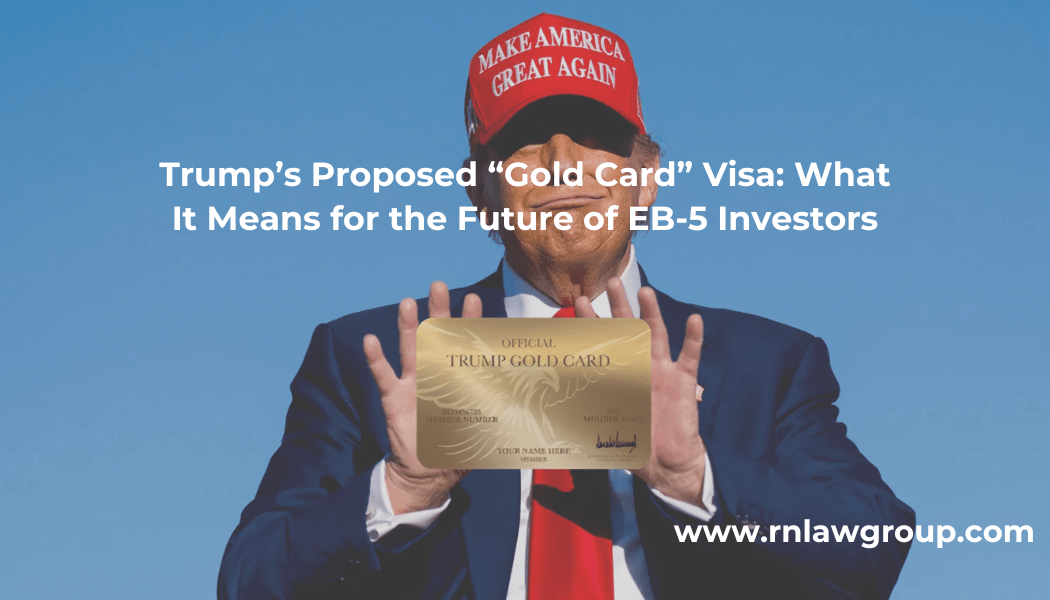
Trump’s Proposed “Gold Card” Visa: What It Means for the Future of EB-5 Investors
Understanding the Proposed Changes to the EB-5 Program
On February 25, 2025, President Donald Trump announced a plan to replace the EB-5 Immigrant Investor Visa Program with a new “Gold Card” visa. This unexpected statement has created significant confusion among current and prospective EB-5 investors, as details about the proposed changes remain scarce and, in some cases, contradictory. It is important to note, there have been NO formal or informal proposals that indicate the actual existence of a gold card program. Notably, as we will discuss later, it legal changes to implement a Gold Card visa have been left off the most recent budget proposals.
Under this “plan”, the Gold Card program would grant permanent residency in exchange for a minimum $5 million investment. However, subsequent statements from the administration have suggested that the EB-5 and Gold Card programs may coexist in some capacity, potentially under the oversight of the Department of Commerce. Despite these claims, few specifics have been provided about eligibility, investment structure, or application procedures.
This announcement has raised concerns within the EB-5 community, particularly for investors who have already committed capital under the existing framework. While some speculate that the Gold Card visa may be an expansion rather than a replacement, others worry about the future of the EB-5 Regional Center Program, which has been instrumental in channeling foreign investment into U.S. projects. The lack of clear guidelines has left many stakeholders—including immigration attorneys, investment firms, and regional center operators—scrambling to understand the potential implications.
President Trump indicated that further details would be released within two weeks of the announcement. However, as of the date of this article, it remains unclear whether the administration intends to eliminate, amend, or integrate the existing EB-5 program, which was most recently reauthorized under the EB-5 Reform and Integrity Act of 2022 (RIA).
Can the President Unilaterally End the EB-5 Program?
A major concern among investors is whether President Trump has the authority to unilaterally repeal or replace the EB-5 program. However, the President cannot single-handedly eliminate the EB-5 program—this requires an act of Congress.
The EB-5 program was originally created in 1990 and later strengthened by the RIA in 2022. Since it is codified in the Immigration and Nationality Act (INA), any effort to repeal or alter the program would require the passage of new legislation through both chambers of Congress.
The Complex Legislative Process
A typical legislative process for repealing or replacing the EB-5 program would include:
- Introduction of a bill in both the House of Representatives and Senate
- Review and debate by relevant Congressional committees
- Amendments and reconciliation of differences between House and Senate versions
- Full floor debates and votes in both chambers
- Presidential approval or veto
Some have speculated that the Gold Card program could go through the budgetary process, which would allow faster processing. This is due to the fact that, unlike other immigration bills that were not allowed to go through the budget bill process as amendments, the intent behind the Gold Card is to directly reduce the deficit. However, as of this article, no mention of the Gold Card or similar programs can be found in the House or Senate proposals for the current budget.
With that in mind, it would likely have to go through the formal bill making process. Given the complexity of this process, any changes to the EB-5 program would likely take months or even years to materialize. Historically, immigration-related legislative changes have faced significant hurdles, requiring bipartisan support, economic justification, and legal scrutiny.
Moreover, previous attempts to introduce significant overhauls to the EB-5 program—such as increasing investment thresholds or tightening regional center regulations—have taken years to pass. Any attempt to dismantle EB-5 in favor of the Gold Card visa would likely face similar challenges, including opposition from lawmakers who recognize the economic benefits of investment-based immigration.
The EB-5 Regional Center Program: Recently Reformed
Under the EB-5 Reform and Integrity Act (RIA), the EB-5 Regional Center (RC) program is authorized through September 30, 2027. This means that unless Congress repeals, modifies, or replaces the program, it will remain in effect until that date. Further, Congress has specifically indicated investment amounts for EB-5 and that cannot be changed by executive order or regulation.
However, given President Trump’s announcement, there is uncertainty about whether the RC Program will be extended beyond 2027 in its current form. If a new investment program with a higher investment threshold—such as the $5 million Gold Card visa—is implemented, it could supersede or restructure the existing RC Program.
The Regional Center model has been particularly beneficial for large-scale commercial developments, as it allows investors to pool funds into government-approved projects, such as infrastructure improvements and real estate ventures. Many investors prefer this indirect job creation model over direct investment because of its lower operational burden and higher likelihood of meeting USCIS job creation requirements.
If the Gold Card visa requires a $5 million investment but does not offer the same flexibility in job creation criteria, it may negatively impact investment flow into certain sectors, potentially limiting opportunities for middle-market investors.
The Economic Impact of the EB-5 Program
How EB-5 Benefits the U.S. Economy
One of the biggest arguments in favor of retaining the EB-5 visa is its proven track record in stimulating the U.S. economy. Unlike other employment-based visas that focus on specialized skills or labor needs, EB-5 injects direct foreign investment into U.S. businesses, promoting job creation and infrastructure development.
Key economic benefits include:
- Billions in Investment – Since the RIA’s implementation, the EB-5 Regional Center Program alone has generated billions in investments with over 6.1 billion invested from 2022 to 2024, and the number continues to rise.
- Job Creation – Every EB-5 investor must create at least 10 full-time jobs for U.S. workers, directly fueling employment growth especially in rural and high unemployment areas. Investments into rural and high unemployment areas allows individuals, especially those from backlogged countries like China and India, to apply for a green card immediately with their EB-5 petition.
- Support for Real Estate & Infrastructure – Many EB-5 projects fund major infrastructure improvements, housing developments, and commercial real estate projects, particularly in Targeted Employment Areas (TEAs).
Could the Gold Card Visa Generate More Economic Growth?
While details remain unclear, one possible motivation for the Gold Card visa could be to attract higher-value investors and generate even greater economic impact than the EB-5 program.
By setting the minimum investment threshold at $5 million, the U.S. government may be:
- Targeting ultra-high-net-worth investors
- Aiming for larger infrastructure investments
- Creating a streamlined pathway for global business leaders
However, increasing the investment amount could also price out many potential investors, particularly those from emerging markets who may struggle to meet such a high financial threshold. It is worth noting that there are limited number of people seeking EB-5 at the amounts set now. Additionally, if the Gold Card visa does not include a job creation requirement, it could face criticism for failing to align with U.S. labor market needs.
Final Thoughts
For EB-5 investors, the next few months will be crucial. While the EB-5 program remains in place, prospective investors should be proactive in filing their petitions before any changes, to ensure their applications are protected under the RIA’s grandfathering provisions.
The proposed Gold Card visa raises several unanswered questions, particularly regarding its economic feasibility, job creation mandates, and processing timelines. Until further details emerge, EB-5 investors should remain vigilant, consult immigration attorneys, and explore alternative investment pathways if necessary.
For continued updates, stay connected with Reddy Neumann Brown PC and visit our blog at rnlawgroup.com/blog for the latest insights into EB-5 and investment-based immigration.
Reddy Neumann Brown PC located in Houston, Texas, has been serving the business community for over 25 years and is Houston’s largest immigration law firm focused solely on U.S. Employment-based and investor-based immigration. We work with employers, employees and investors helping them navigate the immigration process quickly and cost-effectively.
By: Steven Brown.
Steven A. Brown is a Partner at Reddy Neumann Brown PC, where he leads the firm’s Litigation Team, addressing delays and denials of immigration benefits, FOIA requests, and policy and regulatory challenges. Steven is dedicated to delivering practical and effective solutions for clients facing unreasonably delayed or unlawfully withheld immigration benefits, including Employment Authorization Documents (EADs), advance parole, green cards, 221(g) decisions, EB-5 delays, and other immigration-related matters. His litigation efforts were instrumental in Shergill, et al. v. Mayorkas, a landmark case that led to the U.S. government recognizing that under the INA, L-2 and E visa spouses are authorized to work incident to their status, eliminating the need for separate EAD applications. This case has transformed work authorization for thousands of families across the United States.

